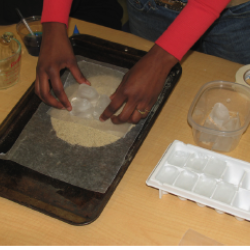Source Institutions
Source Institutions
Add to list Go to activity

In this activity, learners use sand and ice cubes to create a model of permafrost and the effects of the ice melting through the surface. Permafrost is an underground layer of soil, rock and water that remains permanently frozen and is found mostly in polar regions. This activity can be used with lessons on polar regions, climate change, Mars and freezing/melting. This activity can be found on pages 50-51 of the activity guide. [Activity is publicly available through a web crawler capture on Archive.org.]
- 1 to 2 hours
- 45 to 60 minutes
- $1 - $5 per group of students
- Ages 8 - 18
- Activity, Model
- English
Quick Guide
Materials List (per group of students)
- Cookie sheet pan
- Wax paper
- 2 cups of sand
- 4 ice cubes
- Resealable plastic bags
- Paper towels
- Thick book for propping up the tray
- Worksheet – Modelling Ice on Mars
- Observation Sheet
- Pens or pencils
Subjects
-
Earth and Space Science
-
Earth Processes
- Weather and Climate
-
Earth Structure
- Rocks and Minerals
- Oceans and Water
-
Solar System
- The Planets
-
Earth Processes
-
The Nature of Science
-
The Scientific Process
- Conducting Investigations
- Formulating Explanations
- Communicating Results
-
The Scientific Process
Informal Categories
- Model Building
- Nature and Environment
Audience
To use this activity, learners need to:
- see
- touch
Learning styles supported:
- Involves teamwork and communication skills
- Involves hands-on or lab activities
Other
Access Rights:
- Free access
By:
Source Collection
- Science After School Consumer's Guide
Rights:
- All rights reserved, TERC, 2007
Funding Sources:
- NASA, NAS5-26555
- National Science Foundation, NSF 9730728
